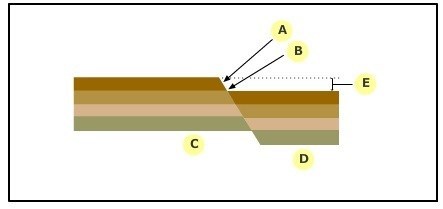🌈 Mariquinha 🏳️🌈 EarthCache
-
Difficulty:
-

-
Terrain:
-

Size:  (other)
(other)
Please note Use of geocaching.com services is subject to the terms and conditions
in our disclaimer.
Earthcache é simples:
Visitar o local, Ler a página do cache, Responder as perguntas para o owner (não no log) e então Registrar... Qualquer dúvida entre em contato
Earthcache is simple:
Visit the site, Read the cache page, Answer the questions for the owner (not in the log) and then Register... Any questions please contact us

A Cachoeira da Mariquinha é uma Unidade de Conservação localizada a aproximadamente 30 quilômetros do centro de Ponta Grossa. No percurso de acesso, a trilha é ladeada por formações de arenito e capões de mata nativa.
Aos pés da sua cascata de 30 metros de altura, forma-se um balneário de rara beleza. Um espaço para aqueles que buscam um contato harmonioso com a natureza, sendo um local ideal para acampamentos e caminhadas nas trilhas pela mata nativa da região.
Uma cachoeira na falha geológica no arenito Furnas
Situa-se no compartimento geomorfológico denominado Segundo Planalto Paranaense, que constitui o segundo degrau do relevo escalonado do Estado do Paraná, sendo limitado a leste pela Escarpa Devoniana e a oeste pela Serra Geral.
A chamada Escarpa Devoniana, tem esse nome por ser em parte sustentada pelos arenitos devonianos da Formação Furnas.
Cachoeiras
São saltos na corrente de um rio. Também chamadas de queda de água, catarata
Podem ser de várias origens:
-Por efeito de capilaridade
-Por intemperismo da superfície do terreno
-Por falhas
-Diferença de resistência das rochas que são atravessadas pelo rio (Se o rio correr ao contrário do esquema, formar-se-á um lago ou um rio de meandros)
-Devido a epirogênese negativa
-Devido a uma dobra monoclinal ou de flexão
Falhas
Ocorrem devido à contínua busca de equilíbrio que se processa entre as rochas desde sua formação. É uma fratura que ocorre nas rochas com subsequente deslocamento dos blocos resultantes.
Quando só ocorre a fratura, estamos diante de uma junta ou diáclase. As falhas podem ocorrer devido ao:
-Atectonismo (ação externa);
-Tectonismo (ação interna); são as falhas mais importantes.
Elementos da falha
A- Plano de falha → Superfície decorrente do falhamento.
B- Linha de falha → Linha de contato entre o plano de falha e a superfície do bloco que desceu.
C- Lapa ou muro → Bloco situado abaixo do plano de falha.
D- Capa ou teto → Bloco situado acima do plano de falha.
E- Rejeito → Medida do deslocamento de um bloco ou dos blocos.

Movimento dos blocos
De translação → não perde o paralelismo após a falha
De rotação → perde o paralelismo após a falha pois pelo menos um bloco sofre giro

Rejeito
É a medida do deslocamento de um bloco ou dos blocos. Podendo ser no plano de falha ou na vertical
Na mesma falha teremos medidas diferentes para o rejeito; portanto, ao indicar o valor do rejeito teremos que especificar se o valor é no plano de falha ou na vertical.
Classificação das falhas
Normal ou de gravidade, o teto baixa em relação ao muro, devido a esforço de tensão.
Inversa ou de empurrão, o teto sobe em relação ao muro, devido a esforço de compressão.
Acavalamento, um tipo particular de falha inversa, na qual o plano de falha tem inclinação menor que 10º, nesta falha o teto cobre completamente o muro.
Horizontal ou de cizalhamento.
Vertical, não ocorre formação de teto nem de muro; apenas um bloco sobe ou desce.
Sistema de falhas
Estamos diante de um sistema quando ocorrer mais de uma falha.
-Graben ou fossa tectônica. É uma depressão estrutural. Ocorre quando as capas descem em relação às lapas.
-Horst ou muralha tectônica. É uma elevação estrutural. Ocorre quando as lapas sobem em relação às capas.
Efeitos do falhamento na topografia
Escarpa de falha
Escarpa de linha de falha
Vale de falha
Sequência de morros
Mudanças bruscas de solo e vegetação (vegetação depende do solo. O solo depende da litologia e do clima)
Observações:
- Rochas semelhantes em climas semelhantes originarão solos semelhantes.
- Rochas semelhantes em climas diferentes originarão solos diferentes.
- Rochas diferentes em climas semelhantes originarão solos diferentes.
- Rochas diferentes em climas diferentes poderão ou não originar solos semelhantes.
Imagens com animações podem ser vistas neste link
Se você visito este local e leu corretamente a descrição pode fazer o log no Earthcache, envie as respostas via Message this owner, se elas porventura não estiverem corretas eu entrarei em contato
Questões:
1- Qual a medida do REJEITO VERTICAL da falha na cachoeira da Mariquinha?
2- Qual o processo de formação desta cachoeira?
3- Sobre os efeitos da falha e da ação da cachoeira, qual é o tipo de material que se encontra na parte de baixo da queda de água?
4- (OPCIONAL) Queria pedir também uma foto sua no local

Mariquinha's waterall is a Conservation Unit located approximately 30 kilometers from the center of Ponta Grossa. In the path of access, the trail is flanked by sandstone formations and native forest beds.
At the foot of its waterfall of 30 meters of height, it forms a seaside of rare beauty. A space for those who seek a harmonious contact with nature, being an ideal place for camping and hiking on the trails through the native forest of the region.
Curious fact:
The day I visited this place, a tourist who went to meet the top side of the waterfall slipped and fell from above!
A waterfall on the geological fault in the Furnas sandstone
It is located in the geomorphological compartment called Second Planalto Paranaense, which is the second step of the stepped relief of the State of Paraná, being limited to the east by the Devonian Escarpment and to the west by Serra Geral.
The so-called Devonian Escarpment, has this name because it is partly sustained by the Devonian sandstones of the Furnas Formation.
Waterfalls
They are jumps in the stream of a river. Also called water fall, cataract
They can be of various origins:
-With effect of capillarity
-For surface weathering of the ground
-Failures
- Resistance difference of rocks that are crossed by the river (If the river runs contrary to the scheme, it will form a lake or a meandering river)
-Due to negative epirogenesis
-Due to a monocline or flexion fold
Failures
They occur due to the continuous search for balance that takes place between rocks since its formation. It is a fracture occurring in the rocks with subsequent displacement of the resulting blocks.
When only the fracture occurs, we are facing a joint or diaclase. Failures can occur due to:
-Atctonism (external action);
-Tectonism (internal action); are the most important failures.
Failure Elements
A- Fault plane → Surface due to failure.
B- Fault line → Line of contact between the fault plane and the surface of the block that has fallen.
C- Lapa or wall → Block located below the fault plane.
D- Cover or ceiling → Block located above the fault plane.
E- Rejection → Measure of the displacement of a block or blocks.

Movement of blocks
Of translation → does not lose parallelism after failure
Rotation → loses parallelism after failure since at least one block suffers rotation

Rejects
It is the measure of the displacement of a block or blocks. Can be in fault plane or upright
In the same fault we will have different measures for the tailings; therefore, when specifying the value of the tailings, we will have to specify whether the value is in the fault plane or in the vertical plane.
Classification of failures
Normal or of gravity, the ceiling low in relation to the wall, due to stress of tension.
Inverse or pushing, the roof rises relative to the wall due to compression effort.
Accumulation, a particular type of reverse fault, in which the fault plane has a slope less than 10º, in this fault the ceiling completely covers the wall.
Horizontal or shear.
Vertical, no ceiling or wall formation occurs; only one block goes up or down.
Fault system
We are facing a system when more than one fault occurs.
-Graben or tectonic fossa. It's a structural depression. Occurs when the layers fall down in relation to the limpets.
-Horst or tectonic wall. It is a structural elevation. It occurs when the limpets rise in relation to the layers.
Effects of failure on topography
Fault flap
Fault Line Fissure
Valley of failure
Sequence of hills
Sudden changes of soil and vegetation (vegetation depends on soil, soil depends on lithology and climate)
Comments:
- Similar rocks in similar climates will give rise to similar soils.
- Similar rocks in different climates will give rise to different soils.
- Different rocks in similar climates will give rise to different soils.
- Different rocks in different climates may or may not give rise to similar soils.
Images with animations can be seen at this link
If you have visited this site and read the description correctly you can log on to Earthcache, send the responses via Message this owner, if they are not correct I will contact you
Questions:
1- What is the measure of the VERTICAL REJECT of the fault in the Mariquinha waterfall?
2- What is the process of formation of this waterfall?
3- On the effects of waterfall failure and action, what kind of material is on the bottom of the waterfall?
4- (OPTIONAL) I also wanted to ask for a photo of you on the spot
Translated by Google
If anyone has a suggestion for improving this, please contact
|
Geo Hugs
|
|

|
Additional Hints
(No hints available.)